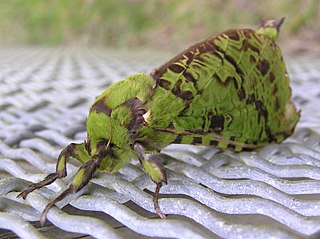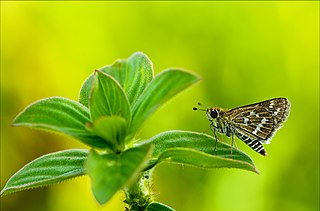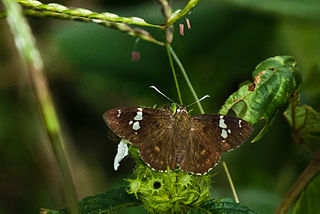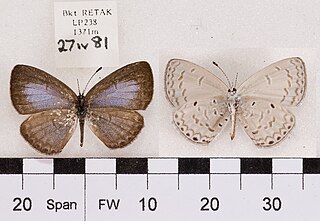
Aenetus is a genus of moths of the family Hepialidae. There are 24 described species found in Indonesia, New Guinea, New Caledonia, Australia and New Zealand. Most species have green or blue forewings and reddish hindwings, but some are predominantly brown or white. The larvae feed in the trunks of living trees, burrowing horizontally into the trunk, then vertically down.

Halpe homolea, the Indian ace or Ceylon ace, is a butterfly belonging to the family Hesperiidae.

Taractrocera maevius, the common grass dart, is a butterfly belonging to the family Hesperiidae found in India, Sri Lanka and Myanmar.

Thoressa astigmata, the southern spotted ace, is a butterfly belonging to the family Hesperiidae. It is endemic to Western ghats and found in Kerala and Karnataka.

Celaenorrhinus ruficornis, the Tamil spotted flat, is a butterfly belonging to the family Hesperiidae which is found in India and Java.

Odontoptilum angulata, the chestnut angle or banded angle, is a butterfly belonging to the family Hesperiidae and is found in India and southeast Asia.

Tagiades litigiosa, the water snow flat, is a butterfly belonging to the family Hesperiidae which is found in India, Sri Lanka, and Myanmar.

Nacaduba berenice, the rounded six-line blue, is a species of lycaenid butterfly found in Indomalayan realm.

Protographium leosthenes, the four-barred swordtail, is a medium-sized butterfly of the family Papilionidae found in Australia. It is similar to the five-barred swordtail found in both Australia and India.

Abantiades latipennis, known as the Pindi moth, is a species of moth in the family Hepialidae. It may also be referred to as a swift moth or a ghost moth, as this is a common name associated with Hepialidae. Endemic to Australia and identified in 1932, it is most populous in temperate rainforest where eucalypti are prevalent, as the larvae feed primarily on the roots of these trees. Females lay eggs during flight in a scattering fashion. The larvae live for over eighteen months underground, while adult moths survive for approximately one week, as they have no mouthparts with which to feed. The moths are preyed upon by a number of predators, including bats and owls. Brown in colour overall, males are paler and the identifying silver bars of the male's wings are more prominent than those of the female's, with dark margins. Male adults are generally smaller.
Abantiades labyrinthicus is a moth of the family Hepialidae. It is endemic to Australia, where it is found in the Australian Capital Territory, New South Wales, Queensland, Tasmania and Victoria.
Abantiades ocellatus is a moth of the family Hepialidae. It is endemic to Western Australia.
Abantiades sericatus is a moth of the family Hepialidae. It is endemic to Western Australia.
Endoclita purpurescens is a species of moth of the family Hepialidae. It was described by Frederic Moore in 1883 and is known from Sri Lanka. Food plants for this species include Camellia and Cinchona.
Fraus simulans, the lesser ghost moth, is a moth of the family Hepialidae. It is endemic to the Australian Capital Territory, New South Wales, Queensland, South Australia, Tasmania, Victoria and Western Australia.

Monodontides musina, the Swinhoe's hedge blue, is a butterfly of the family Lycaenidae. It is found in South-East Asia, including India.
Oreta singapura is a moth in the family Drepanidae. It was described by Charles Swinhoe in 1892. It is found in Singapore, Malaysia, Indonesia and New Guinea.














